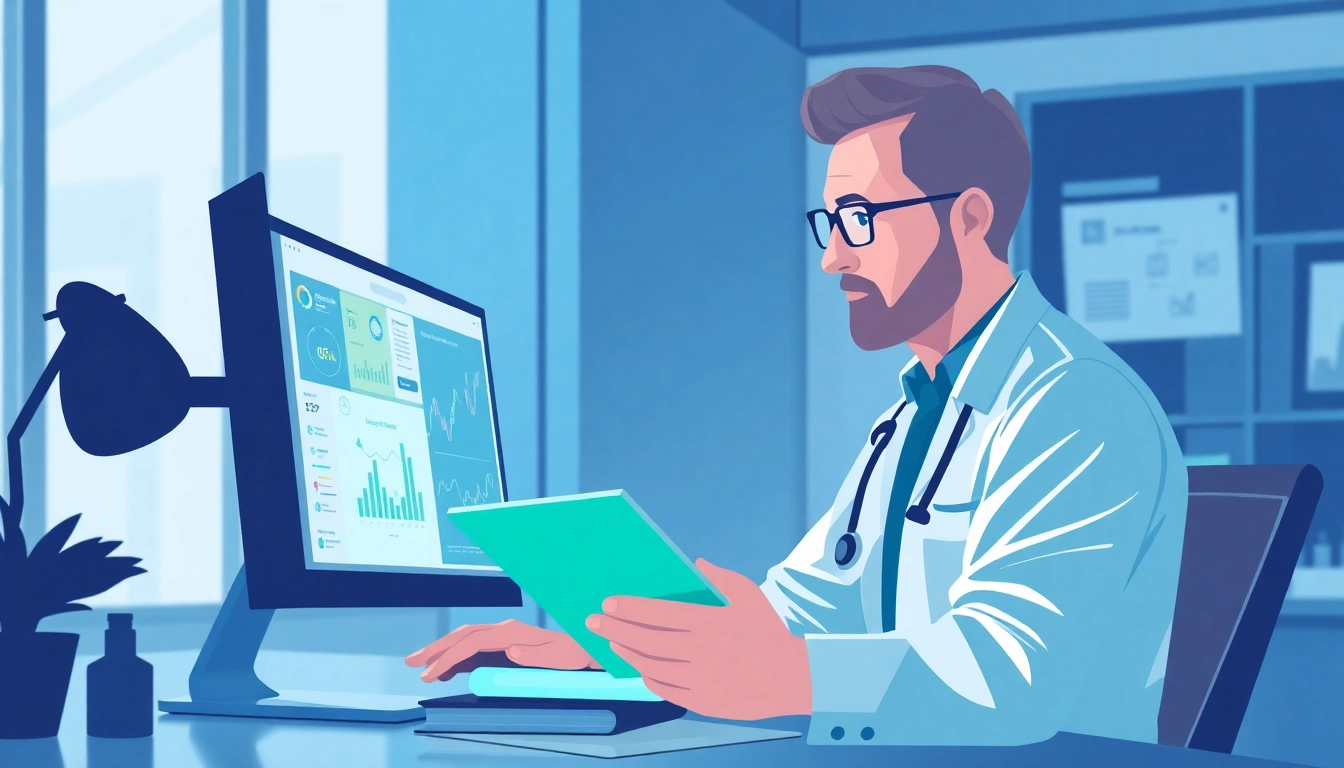Understanding Informatics in Healthcare
What is Informatics?
Informatics is a multidimensional field that intersects information science, computer science, and domain-specific knowledge, such as healthcare. It encompasses the methods and techniques applied to manage data, facilitate the flow of communication, and utilize knowledge, particularly in the medical domain. As healthcare increasingly integrates advanced technologies, such as artificial intelligence and machine learning, informatics plays a critical role in transforming data into actionable insights that drive healthcare improvements.
At its core, www.informaticsview.com provides a platform for educating healthcare professionals about the various dimensions of informatics, showcasing how the effective use of data and information can significantly enhance patient care and operational efficiencies.
The Role of Data in Healthcare
The role of data in healthcare is pivotal. With the advent of electronic health records (EHRs) and big data analytics, healthcare providers now have access to vast amounts of information pertaining to patient histories, treatment outcomes, and operational metrics. Properly managed, this data can improve healthcare services significantly. Key applications include enhancing clinical decision-making, identifying patient trends, improving operational workflows, and supporting population health management.
Furthermore, the ability to analyze this data allows for the identification of inefficiencies and the development of targeted interventions that can lead to better health outcomes. For example, predictive analytics can help identify at-risk populations and initiate preventative care strategies earlier, ultimately reducing healthcare costs and improving patient satisfaction.
Key Concepts in Health Informatics
Health informatics operates on several key concepts that define its impact on healthcare delivery:
- Electronic Health Records (EHRs): EHRs are secure, real-time digital versions of patients’ paper charts, enabling health professionals to access and share patient information seamlessly.
- Clinical Decision Support Systems (CDSS): CDSS provide healthcare professionals with knowledge and specific patient information, intelligently filtered and presented at appropriate times, to enhance patient care.
- Health Information Exchange (HIE): HIE refers to the electronic movement of health-related information among organizations. It improves care coordination and streamlines patient management.
- Telemedicine: Telemedicine expands access to care, allowing patients to consult healthcare professionals remotely through technology, reducing the need for in-person visits.
- Data Analytics: This encompasses various techniques (descriptive, predictive, prescriptive analytics) that transform raw data into meaningful insights, guiding healthcare strategies and improving outcomes.
Importance of Health Informatics
Improving Patient Care through Informatics
Informatics has revolutionized patient care by enhancing the quality and efficiency of services provided by healthcare organizations. By leveraging accurate data to inform clinical decisions, healthcare providers can personalize treatments, minimize errors, and ensure that patients receive the most appropriate interventions tailored to their needs.
One of the most significant advantages is that informatics facilitates better communication among different healthcare providers, which is especially crucial in managing patients with complex conditions. Through shared access to a patient’s health records, different specialists can collaborate more effectively, ensuring coherent care and preventing the exacerbation of health conditions through fragmented approaches.
Informatics and Decision Support Systems
Clinical Decision Support Systems (CDSS) is crucial tools in informatics that provide evidence-based knowledge to professionals at the point of care. By incorporating algorithms and guidelines, these systems can help in diagnosis, treatment planning, and risk management.
For instance, a CDSS can alert a physician about potential drug interactions while prescribing medication or remind them of a patient’s allergies, significantly reducing the risk of adverse events. The use of CDSS not only leads to improved health outcomes but also enhances the confidence healthcare professionals have in their clinical decisions.
Case Studies Showcasing Successful Implementations
Numerous case studies illustrate the successful implementation of informatics within healthcare systems:
Case Study 1: One prominent hospital in the Midwest implemented a comprehensive EHR system that integrated all patient data across departments. As a result, they experienced a 30% decrease in medication errors and a 20% increase in patient satisfaction ratings.
Case Study 2: A community health organization utilized predictive analytics to identify high-risk patients based on their medical histories. This proactive approach resulted in preventative outreach efforts, ultimately reducing hospital readmissions by 15%.
These examples underscore how leveraging informatics can lead to tangible improvements in healthcare delivery, showcasing its critical importance in modern healthcare systems.
Technology Transformations in Healthcare
Impact of EHRs on Patient Management
The introduction of Electronic Health Records has transformed patient management, streamlining how healthcare providers document and retrieve patient information. EHRs centralize medical records, allowing for instant access to patient histories, treatments, and outcomes, thus promoting better coordination of care.
Healthcare providers using EHR systems can quickly identify trends and benchmarks within patient populations, leading to improved clinical effectiveness. Furthermore, EHRs facilitate better health monitoring, enabling timely interventions that can prevent complications and unnecessary hospitalizations.
Telemedicine and its Evolving Role
Telemedicine has emerged as a vital tool for healthcare delivery, particularly highlighted during the recent global pandemic. It allows patients to receive care from the comfort of their homes, which is crucial for those with mobility issues or in rural areas where access to healthcare facilities may be limited.
Through telemedicine, healthcare professionals can conduct consultations, monitor chronic diseases, and deliver mental health support effectively. The ability to record and share data in real time means healthcare of equal quality is accessible regardless of physical distance, paving the way for a more inclusive healthcare system.
The Future of Healthcare Technology
As healthcare continues to evolve, the future of technology in this field promises exciting advancements. Innovations such as artificial intelligence (AI) will likely further enhance diagnostic accuracy and predictive analytics, driving more personalized patient care. Moreover, the integration of wearable health technology provides continuous monitoring capabilities, empowering individuals to take an active role in managing their health.
Ultimately, the combination of these advancements stands to revolutionize how care is delivered, ensuring that it is more efficient, equitable, and patient-centered.
Challenges in Implementing Informatics
Common Barriers Faced by Healthcare Providers
Despite the numerous benefits of health informatics, several barriers hinder its successful implementation. These include financial constraints, resistance to change among healthcare staff, and the complex integration of new technology with existing systems. Additionally, the variability in technological competency among healthcare professionals can lead to inconsistencies in data usage and interpretation.
To address these problems, organizations need to foster a culture that supports ongoing education and training, ensuring that all employees are proficient in utilizing new technologies effectively.
Data Security and Privacy Issues
With the increasing reliance on digital records comes heightened concerns regarding data security and patient privacy. Healthcare organizations must comply with strict regulations such as HIPAA (Health Insurance Portability and Accountability Act) to safeguard sensitive patient data from cyber threats and breaches.
Robust cybersecurity measures, including encryption and regular security audits, are essential to mitigate risks. Additionally, educating staff about best practices for data protection can significantly reduce the chance of accidental breaches and ensure patient trust in systems used for their care.
Strategies for Overcoming Implementation Challenges
Overcoming the challenges associated with implementing informatics requires a strategic approach. Key strategies include:
- Investment in Training: Continuous education and training for staff will empower them to effectively use informatics tools and adapt to new technologies.
- Engagement of Stakeholders: Involving a range of stakeholders—including healthcare professionals, IT staff, and patients—in the decision-making process can ease the transition and enhance buy-in.
- Pilot Programs: Implementing pilot programs allows organizations to test new technologies on a smaller scale and make necessary adjustments before a full rollout.
- Building a Culture of Innovation: Fostering an environment where staff feel encouraged to adapt to changes and share feedback can improve the acceptance of informatics initiatives.
The Future of Health Informatics
Predictions for the Next Decade
Looking ahead to the future of health informatics, several trends are expected to shape its evolution:
– Integration of AI: More healthcare systems will leverage AI-driven analytics to provide deeper insights into patient care and operational efficiencies.
– Personalized Medicine: As genomics and personalized medicine gain traction, health informatics will play a critical role in tailoring treatment plans based on individual genetic profiles.
– Enhanced Interoperability: Increased focus on creating interoperable systems will enable seamless information exchange between healthcare providers, improving care coordination.
Innovations in Healthcare Informatics
Innovations such as blockchain technology may revolutionize health informatics by providing a secure way to share and store patient data. Furthermore, advancements in natural language processing will allow healthcare providers to convert unstructured data from clinical notes into actionable insights, supporting clinicians in decision-making.
Additionally, integrating patient-generated health data from wearables and mobile apps will further enhance patient engagement and lead to more informed health decisions.
How www.informaticsview.com Can Help Professionals
For healthcare professionals seeking to navigate the evolving landscape of health informatics, resources available at www.informaticsview.com can serve as an invaluable tool. The platform offers articles, case studies, and insights on best practices that help inform and enhance the understanding of informatics applications within healthcare.
As health informatics continues to evolve, utilizing resources that keep professionals informed will be essential for leveraging the full potential of emerging technologies and practices in improving patient care outcomes.



